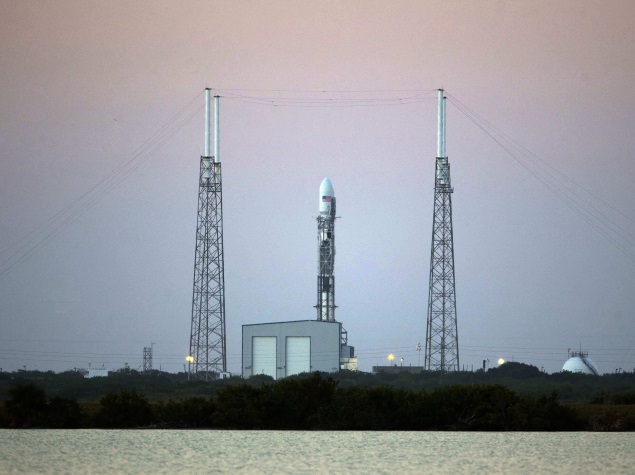- Home
- Science
- Science News
- Glitch Delays Launch of SpaceX Rocket With US Weather Satellite
Glitch Delays Launch of SpaceX Rocket With US Weather Satellite

Launch had been targeted for 6:10 p.m. EST (2310 GMT) from Cape Canaveral Air Force Station in Florida. But about 2.5 minutes before liftoff, a problem cropped up with an Air Force radar system needed to track the rocket in flight.
The next opportunity to launch is 6:07 p.m. EST (2307 GMT) on Monday, said Nasa launch commentator Michael Curie.
The rocket carries the Deep Space ClimateObservatory, nicknamed DSCOVR, a partnership of Nasa and theNational Oceanic and Atmospheric Administration.
DSCOVR is expected to replace a 17-year-old satellite monitoring for potentially dangerous solar storms. Tsunamis of charged particles from the sun, called coronal mass ejections, can disrupt GPS and other satellite signals, block radiocommunications and impact electric power grids on Earth, NOAA said.
"We think of DSCOVR as a weather buoy," NOAA administrator and former astronaut Kathryn Sullivan said during a Nasa launch webcast.
"It senses first the blasts of solar wind and embedded magnetic fields that are potentially going to wreak some havoc."
Following launch, DSCOVR will take more than three months to reach its operational orbit around the sun, almost 1 million miles (1.6 million) km inward from Earth.
The satellite's original mission, championed by then-VicePresident Al Gore, was to provide a near-continuous view ofEarth that would be distributed via the Internet in an attemptto raise environmental awareness, much like the iconic Apollo 17"Blue Marble" picture of Earth did in the early 1970s.
The satellite, then called Triana - and lampooned as"GoreSat" - was due to launch on the ill-fated space shuttleColumbia mission in 2003, but it was pulled from the manifestand put into storage after President George H.W. Bush moved intothe White House.
A decade later, Triana was refurbished and reborn as theDSCOVR solar observatory. In addition to instruments to studythe solar wind, it has two sensors for Earth scienceobservations, such as tracking volcanic plumes,measuring ozone and monitoring droughts, flooding and fires.
The satellite also will take pictures of Earth every two hours that will be posted on the Internet the next day, fulfilling in part Gore's dream.
"The opportunity for every man, woman and child who lives on the Earth to see ... their own home in the context of the whole can add to our way of thinking about our relationship to the Earth," Gore, who was at the Kennedy Space Center to watch the launch, told reporters.
© Thomson Reuters 2015
Get your daily dose of tech news, reviews, and insights, in under 80 characters on Gadgets 360 Turbo. Connect with fellow tech lovers on our Forum. Follow us on X, Facebook, WhatsApp, Threads and Google News for instant updates. Catch all the action on our YouTube channel.
Related Stories
- Samsung Galaxy Unpacked 2025
- ChatGPT
- Redmi Note 14 Pro+
- iPhone 16
- Apple Vision Pro
- Oneplus 12
- OnePlus Nord CE 3 Lite 5G
- iPhone 13
- Xiaomi 14 Pro
- Oppo Find N3
- Tecno Spark Go (2023)
- Realme V30
- Best Phones Under 25000
- Samsung Galaxy S24 Series
- Cryptocurrency
- iQoo 12
- Samsung Galaxy S24 Ultra
- Giottus
- Samsung Galaxy Z Flip 5
- Apple 'Scary Fast'
- Housefull 5
- GoPro Hero 12 Black Review
- Invincible Season 2
- JioGlass
- HD Ready TV
- Laptop Under 50000
- Smartwatch Under 10000
- Latest Mobile Phones
- Compare Phones
- Realme P4x 5G
- OnePlus Ace 6T
- OPPO A6x 5G
- Samsung Galaxy Z TriFold
- Poco F8 Ultra
- Poco F8 Pro
- Huawei Mate 80 RS Master Edition
- Huawei Mate 80 Pro Max
- Asus ProArt P16
- MacBook Pro 14-inch (M5, 2025)
- Poco Pad M1
- Poco Pad X1
- Just Corseca Skywatch Pro
- Honor Watch X5
- Acerpure Nitro Z Series 100-inch QLED TV
- Samsung 43 Inch LED Ultra HD (4K) Smart TV (UA43UE81AFULXL)
- Asus ROG Ally
- Nintendo Switch Lite
- Haier 1.6 Ton 5 Star Inverter Split AC (HSU19G-MZAID5BN-INV)
- Haier 1.6 Ton 5 Star Inverter Split AC (HSU19G-MZAIM5BN-INV)
-
 Airtel Discontinues Two Prepaid Recharge Packs in India With Data Benefits, Free Airtel Xtreme Play Subscription
Airtel Discontinues Two Prepaid Recharge Packs in India With Data Benefits, Free Airtel Xtreme Play Subscription
-
 Samsung Galaxy Phones, Devices Are Now Available via Instamart With 10-Minute Instant Delivery
Samsung Galaxy Phones, Devices Are Now Available via Instamart With 10-Minute Instant Delivery
-
 NotebookLM App Gets an In-Built Camera, Lets Users Upload Images as a Source
NotebookLM App Gets an In-Built Camera, Lets Users Upload Images as a Source
-
 HMD 101 Launched in India With 1,000mAh Battery, Auto Call Recording Alongside HMD 100: Price, Features
HMD 101 Launched in India With 1,000mAh Battery, Auto Call Recording Alongside HMD 100: Price, Features












